Summer is right around the corner, and as temperatures rise, you may begin to see more yellow and black flying insects around your property. But would you be able to identify if it was a wasp or a hornet? In this article, we’ll teach you how by showing you the most common wasps and hornets found here in Oregon and Washington state. This is an important skill to have because proper identification is the first step to knowing what to do next. Are they fine to ignore, or should you call a professional to take care of the problem?
What is a Wasp?
Let’s start by talking about what a wasp actually is. Wasps are part of the Vespidae family, which also includes yellow jackets, paper wasps, and hornets. So, yes, all hornets are wasps. Wasps are long and thin and come in a variety of colors, including black and yellow, and even orange. They have three sets of legs, strong mandibles, and a stinger which they can use multiple times on their victims. Wasps build paper nests out of wood fibers and are aggressive if provoked. They also release a hormone that will alert others there is danger and to attack.
Here are some key differences between wasps and bees:
- Appearance: Wasps and longer and narrower; bees generally have more rounded, fuzzy bodies, which aids in pollen collection.
- Behavior: Bees are social insects that are focused on helping their colony; wasps can be solitary and aggressive.
- Ecological role: Many wasps are pollinators, but they also serve an important role as predators; bees are vital for pollination and are not predators.
- Nests: Wasp nests can be found in a variety of locations, depending on the species, including underground or in your eaves or trees; their nests may be made of paper or chewed plant material. Bees generally place their nests in a protected location, such as inside a tree cavity.
Common Wasps of the Pacific Northwest
Entomologists believe there are more than a hundred thousand different types of wasps around the world. Fortunately, here in the PNW, there are only a handful of types that are common. Those include yellow jackets, paper wasps, mud daubers, and bald-faced hornets. We’ll also tell you about “murder hornets,” which aren’t common, but people still want to know about them because of their intimidating nature.
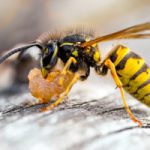
Yellow Jackets
- Yellow jackets are the most common wasp species in the PNW
- About ½” long with black and yellow stripes down their abdomen
- Narrow waist and three pairs of legs
- Round paper nests — which could be aerial or in the ground
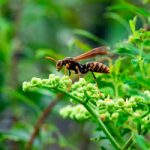
Paper Wasps
- Paper wasps are brownish with red or yellow markings
- Approximately 1″ long with slender waists
- Less aggressive than yellow jackets, but will sting if you get too close
- Umbrella-shaped paper nests near eaves, decks, and trees
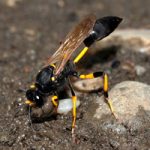
Mud Daubers
- Not aggressive; rarely sting
- Typically a single color — black or blue — but some can also come with markings
- Extremely slender waists
- Nests are mud tube nests usually near eaves, in attics, or under bridges
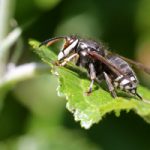
Bald-Faced Hornets
- Mostlly black in color with white markings
- Build nests out of paper, generally away from human activity
- Not very aggressive but still sting if you get too close
Asian Giant Hornets aka “Murder Hornets”
 The largest hornet in the world, ranging from 1.5″ to 2″
The largest hornet in the world, ranging from 1.5″ to 2″- Yellow-orange face with a yellow and black banded thorax
- Not native to North America, and extremely rare, but there have been sightings of them in Washington state
- Kill honeybees to give to their growing young
- Highly aggressive and will not hesitate to sting a person
Need Wasp Control Service?
If you have a stinging insect problem on your property, it may be time to call your local wasp control or hornet control specialists a call. Antworks specializes in fast and reliable pest control in the Portland and Vancouver metropolitan area, so call us today to schedule your appointment.

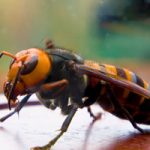 The largest hornet in the world, ranging from 1.5″ to 2″
The largest hornet in the world, ranging from 1.5″ to 2″





